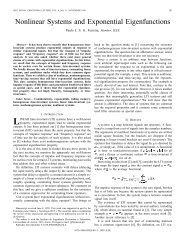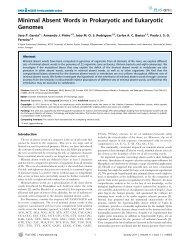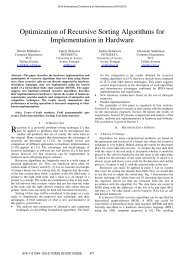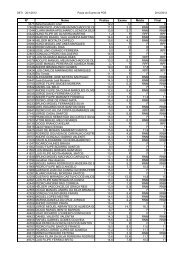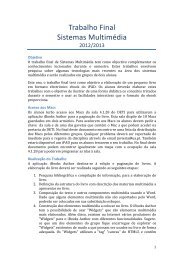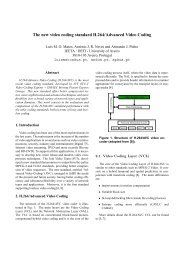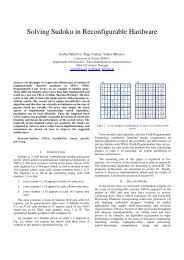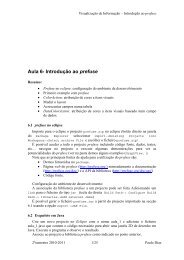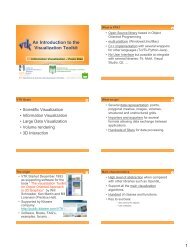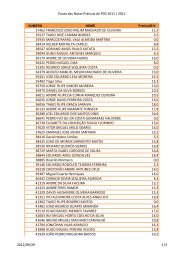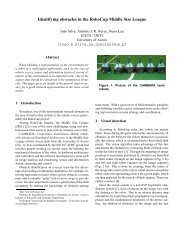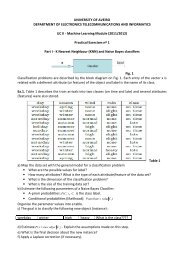Reuse Technique in Hardware Design - Sweet
Reuse Technique in Hardware Design - Sweet
Reuse Technique in Hardware Design - Sweet
You also want an ePaper? Increase the reach of your titles
YUMPU automatically turns print PDFs into web optimized ePapers that Google loves.
proposed. This architecture has to be able to implement<br />
all the desired functionalities (all the required <strong>in</strong>terfaces<br />
for our example). On the other hand it has to be built <strong>in</strong><br />
such a way that it can be optimized for any particular<br />
functionality that is needed for the considered device. In<br />
other words, we would like to be able to personalize and<br />
to optimize this architecture for any customized circuit<br />
that belongs to the selected application-specific area. At<br />
the second step, the HT has to be implemented and tested<br />
<strong>in</strong> software. This allows to validate its correctness and to<br />
analyze its effectiveness for solv<strong>in</strong>g various particular<br />
tasks. At the next step, the template has to be<br />
implemented and verified <strong>in</strong> hardware. F<strong>in</strong>ally, we can<br />
use the HT for solv<strong>in</strong>g problems from the selected area.<br />
It is very important that there exists a personalization<br />
of HT implementations from “more targeted to software<br />
specifications” to “more targeted to hardware<br />
specifications”. Thus, relationships between different<br />
levels of hardware specifications considered <strong>in</strong> the<br />
previous sections can easily be established. Indeed,<br />
mutual <strong>in</strong>terdependence of the levels enables the<br />
designers to achieve a number of advantages, such as the<br />
follow<strong>in</strong>g:<br />
• Specification of the HT can be done at any desired<br />
level, i.e. general-purpose language, system-level<br />
specification language and hardware description<br />
language.<br />
• S<strong>in</strong>ce there exists software implementation of HT, all<br />
the required configurations can be generated, debugged<br />
and tested <strong>in</strong> general-purpose computer and prepared for<br />
future upload<strong>in</strong>g to the relevant hardware.<br />
• There exists an opportunity of run-time<br />
reconfiguration (reprogramm<strong>in</strong>g HT blocks), which is a<br />
very challeng<strong>in</strong>g feature for virtual adaptive systems.<br />
In order to provide a more compact software HT<br />
model we will use an object-oriented description<br />
proposed <strong>in</strong> [11] with the aid of C++ classes (see Fig. 3).<br />
The top-level specification <strong>in</strong>cludes just two classes that<br />
are an abstract class datapath_template and a concrete<br />
class FSM_template. Note that the datapath <strong>in</strong> Fig. 3 can<br />
also <strong>in</strong>clude a similar HT of a lower level.<br />
It is assumed that the problem can be solved with the<br />
aid of the function Solve, which executes an algorithm<br />
described by the argument FSM_template&. An<br />
<strong>in</strong>teraction between the classes datapath_template and<br />
FSM_template has been organized through the functions<br />
Run <strong>in</strong> such a way that the function<br />
FSM_template::Run(X) takes arguments presented <strong>in</strong> the<br />
<strong>in</strong>put vector X and returns outputs <strong>in</strong> form of vector Y;<br />
the function datapath_template::Run(Y) takes arguments<br />
presented <strong>in</strong> the vector Y and returns outputs <strong>in</strong> form of<br />
vector X.<br />
The class datapath_template describes a general<br />
structure of hardware that can be used for solv<strong>in</strong>g an<br />
application-specific subset of tasks. The functions Solve<br />
and Run are pure virtual functions because we <strong>in</strong>tend to<br />
model just a general structure for a subset of similar tasks<br />
and we do not have yet any particular implementation.<br />
The latter can be described by a concrete class derived<br />
from the class datapath_template <strong>in</strong> such a way that the<br />
considered above general structure is either reused<br />
without any change or extended. In order to solve<br />
different problems with the aid of the same datapath<br />
(execution unit) we have to be able to change the<br />
sequence of operations that is generated by control<br />
circuits, i.e. we have to alter the behavior of the<br />
respective RFSM(s). It is important to provide such<br />
modifications not only for software model (which is<br />
flexible by def<strong>in</strong>ition), but also for the relevant hardware<br />
model. The latter is proposed <strong>in</strong> [11] and synthesis of<br />
RFSM can be done with the aid of methods [12]. In<br />
general, an RFSM is composed of two blocks (see fig. 3):<br />
a RAM-based core with customizable behavior, and a<br />
controller, which permits to configure the core <strong>in</strong> such a<br />
way that enables us to implement the desired particular<br />
behavior.<br />
C++ model<br />
<strong>Hardware</strong> model<br />
class datapath_template<br />
{ public:<br />
datapath_template();<br />
virtual unsigned Run(unsigned Y)= 0;<br />
virtual unsigned Solve(FSM_template&)=0;<br />
// ..... other functions<br />
};<br />
Y<br />
class FSM_template<br />
{ public:<br />
FSM_template(<strong>in</strong>t L, <strong>in</strong>t R, <strong>in</strong>t N, <strong>in</strong>t G,<br />
/*memory specification*/)<br />
unsigned Run(unsigned X);<br />
void Reload(/*memory specification*/);<br />
void Switch(/*memory segment*/);<br />
};<br />
These functions permit to<br />
change the FSM functionality<br />
X<br />
This function executes a state<br />
transition and generates outputs<br />
DATAPATH<br />
Y<br />
RFSM core<br />
X<br />
RFSM<br />
Controller, which permits the<br />
RFSM behavior to be changed<br />
Fig. 3. Relationship between software and<br />
hardware models<br />
The functions Run and Solve can properly be<br />
described after we study a specific class of applications.<br />
For example, let us exam<strong>in</strong>e comb<strong>in</strong>atorial search<br />
algorithms formulated over b<strong>in</strong>ary and ternary matrices,<br />
such as matrix cover<strong>in</strong>g, the Boolean satisfiability, graph<br />
color<strong>in</strong>g, etc. It is known that the execution unit<br />
(datapath) for such algorithms can be constructed <strong>in</strong> such<br />
a way that it will be common for different problems [13].<br />
Customization of operations for the concrete problem can<br />
be done through modification of control algorithms<br />
implemented <strong>in</strong> the respective control unit (which is the<br />
RFSM). All the required details and examples of such<br />
customization are presented <strong>in</strong> [13]. The same technique<br />
can be applied to other problems, such as sort<strong>in</strong>g and<br />
order<strong>in</strong>g algorithms [14], data compression/<br />
decompression algorithms [15], etc. Note that for the



